最全的新概念英语第一册语法汇总[1]
新概念英语第一册各课语法知识汇总
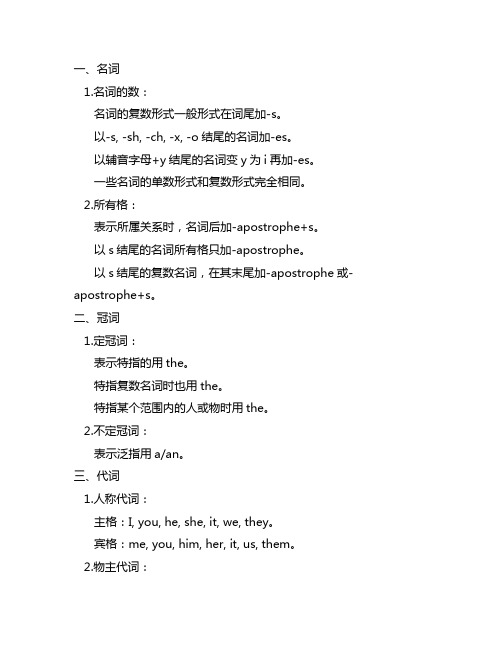
一、名词1.名词的数:名词的复数形式一般形式在词尾加-s。
以-s, -sh, -ch, -x, -o结尾的名词加-es。
以辅音字母+y结尾的名词变y为i再加-es。
一些名词的单数形式和复数形式完全相同。
2.所有格:表示所属关系时,名词后加-apostrophe+s。
以s结尾的名词所有格只加-apostrophe。
以s结尾的复数名词,在其末尾加-apostrophe或-apostrophe+s。
二、冠词1.定冠词:表示特指的用the。
特指复数名词时也用the。
特指某个范围内的人或物时用the。
2.不定冠词:表示泛指用a/an。
三、代词1.人称代词:主格:I, you, he, she, it, we, they。
宾格:me, you, him, her, it, us, them。
2.物主代词:形容词性物主代词:my, your, his, her, its, our, their。
名词性物主代词:mine, yours, his, hers, its, ours, theirs。
3.指示代词:this, that, these, those。
4.不定代词:some, any, no, every, each, many, much, few, little。
四、形容词1.形容词的用法:在名词前作定语。
在系动词之后作表语。
2.比较级和最高级:比较级:比较两者时,用比较级。
最高级:表示三者或三者以上之间的比较。
五、动词1.动词的三单形式:一般情况,动词第三人称单数在末尾加-s。
以辅音字母加y结尾的动词变y为i再加-es。
直接在词尾加-es的动词。
2.动词的现在进行时:am/is/are+动词的现在分词。
3.行为动词的过去式:动词过去式变化规则有规则动词和不规则动词。
六、副词1.副词的用法:修饰动词、形容词、副词。
表示时间、地点、原因、目的等。
2.比较级和最高级:副词比较级和最高级的构成。
七、介词1.介词的基本用法:表示方位、时间、原因、目的等。
新概念英语第一册语法归纳全篇

可编辑修改精选全文完整版新概念英语第一册语法归纳新概念英语第一册语法归纳《新概念英语》作为一套世界闻名的英语教程,以其全新的教学理念,有趣的课文内容和全面的技能训练,深受广大英语学习者的欢迎和喜爱。
以下店铺为大家整理的新概念英语第一册语法归纳,欢迎阅读!新概念英语第一册语法归纳篇1感叹句感叹句:1)What +名词+主语+谓语What a beautiful girl she is!What tall buildings they are!2)How +形容词+主语+谓语How beautiful the girl is!How tall the buildings are!在口语中,感叹句的主语和谓语常常省略:What a nice present!(省略it is)How disappointed!(省略she is或其它可作本句主、谓的词语) 祈使句祈使句表示请求、命令、建议、邀请等,谓语动词一律用原型,句子中通常不用主语,句末用惊叹好或者句号,用降调。
肯定句:动词原型Come here,please.Go downstairs,please.Stand up.Sit down.Be quiet.Be careful.祈使句中如果有唤语,一定要用逗号隔开,放在句首或者句尾:Come in,Amy.Sit down here,Tom.Mary,give me a book please.否定:Don't+动词原型Don't come here.Don't sit down.Don't stand up.Don't give me it.let sb. do 让某人做Let me pass.Let us have a rest.Let's have a rest.反意疑问:Let's have a walk along the river,shall we?Let us go out for a drink,will you?so/neither的倒装倒装句:so/neither的倒装eg: He can swim. So can I.She didn't go to class. Neither did I.结构:so/neither+be+ 主语so/neither+助动词+ 主语so/neither+情态动词+ 主语助动词:一般现在时: do,does/am,is,are现在进行时: am,is,are一般过去时: did现在完成时: have,has一般将来时: will,shall过去进行时: was,were过去完成时: had过去将来时: would直接引语/间接引语如果引语的主句所用动词为过去时,那么间接引语要做相应变化:时态,人称,时间地点及指示词1)时态变化:一般现在时——一般过去时现在进行时——过去进行时一般过去时——过去完成时现在完成时——过去完成时一般将来时——过去将来时be going to——was/were going to/wouldcan--couldmay--might2)时间地点及指示词的变化:here-there,tomorrow-the next day,the following day,this-that…3)人称变化:根据句意改变人称。
新概念英语一册语法总结
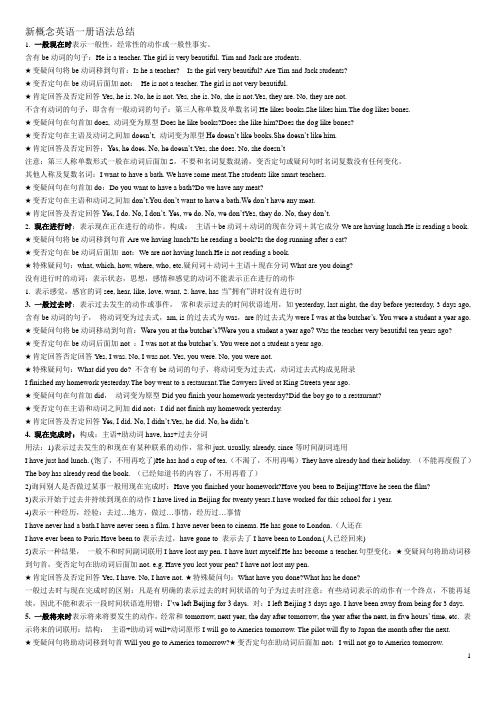
新概念英语一册语法总结1. 一般现在时表示一般性,经常性的动作或一般性事实。
含有be动词的句子:He is a teacher. The girl is very beautiful. Tim and Jack are students.★变疑问句将be动词移到句首:Is he a teacher? Is the girl very beautiful? Are Tim and Jack students?★变否定句在be动词后面加not:He is not a teacher. The girl is not very beautiful.★肯定回答及否定回答Yes, he is. No, he is not. Yes, she is. No, she is not.Yes, they are. No, they are not.不含有动词的句子,即含有一般动词的句子:第三人称单数及单数名词He likes books.She likes him.The dog likes bones.★变疑问句在句首加does, 动词变为原型Does he like books?Does she like him?Does the dog like bones?★变否定句在主语及动词之间加doesn’t, 动词变为原型He doesn’t like books.She doesn’t like him.★肯定回答及否定回答:Yes, he does. No, he doesn’t.Yes, she does. No, she does n’t注意:第三人称单数形式一般在动词后面加S,不要和名词复数混淆,变否定句或疑问句时名词复数没有任何变化。
其他人称及复数名词:I want to have a bath. We have some meat.The students like smart teachers.★变疑问句在句首加do:Do you want to have a bath?Do we have any meat?★变否定句在主语和动词之间加don’t.You don’t want to have a bath.We don’t have any meat.★肯定回答及否定回答Yes, I do. No, I don’t. Yes, we do. No, we don’t Yes, th ey do. No, they don’t.2. 现在进行时:表示现在正在进行的动作。
新概念英语第一册语法【五篇】

【导语】芬芳袭⼈花枝俏,喜⽓盈门捷报到。
⼼花怒放看通知,梦想实现今⽇事,喜笑颜开忆往昔,勤学苦读最美丽。
在学习中学会复习,在运⽤中培养能⼒,在总结中不断提⾼。
以下是为⼤家整理的《新概念英语第⼀册语法【五篇】》供您查阅。
【第⼀篇:动词的变化】 1)代词及be动词 主格 I we you you she/he/it they 宾格 me us you you her/him/it them 代词所有格 my our your your her/his/its their 名词性代词 mine ours yours yours hers/his/its theirs be动词现在时 Am are are are is are be动词过去时 was were were were was were 2)名词的复数 规则变化的名词复数形式 规则1 ⼀般情况+s e.g. shell→shells toy→toys 规则2 以s, x, ch, sh结尾+es e.g. fox→foxes church→churches 规则3 以o结尾+s或+es e.g. radio→radios potato→potatoes 规则4 以f, fe结尾的,变f, fe为ves e.g. life→lives half→halves 规则5 以辅⾳字母+y结尾,变y为i+es e.g. sky→skies study→studies 3)动词的第三⼈称单数形式 规则1 ⼀般情况+s e.g. like-likes, look-looks 规则2 以s, x, ch, sh和o结尾+es e.g. do-does, catch-catches 规则3 以辅⾳字母+y结尾,变y为i+es e.g. carry-carries, fly-flies 4)动词现在分词 规则1 ⼀般动词加-ing e.g. look-looking, read-reading, play-playing 规则2 以不发⾳的字母结尾的单词去e加-ing e.g. make-making, take-taking, arrive-arriving 规则3 重读闭⾳节词结尾,即单词中只有⼀个元⾳字母,其后紧跟⼀个辅⾳字母的词,双写辅⾳字母再加-ing e. g. run-running, sit-sitting, get-getting, swim-swimming, stop-stopping 5)动词过去式 规则动词变化 规则1 ⼀般动词加-ed e.g. look-looked, watch-watched, play-played 规则2 以e结尾的加-d e.g. make-maked, arrive-arrived 规则3 以辅⾳字母y结尾的变y为i加-ed cry-cried, carry-carried 规则4 重读闭⾳节词结尾,即单词中只有⼀个元⾳字母,其后紧跟⼀个辅⾳字母的词,双写辅⾳字母再加-ed stop-stopped 过去式的读⾳ 在清辅⾳后⾯(除外)读/t/ e.g. walked, jumped 在浊辅⾳和元⾳后读/d/ e.g. washed, watched 在/t/,/d/后读/id/ e.g. waited, hated 6)形容词和副词的⽐较级和级 ⽐较级 规则1 ⼀般加-er e.g. high-higher 规则2 以e结尾加-r nice-nicer 规则3 以辅⾳字母加y结尾,变y为i再加-er busy-busier 规则4 重读闭⾳节结尾,双写辅⾳字母再加-er fat-fatter 级 规则1 ⼀般加-est e.g. high-highest 规则2 以e结尾加-st nice-nicest 规则3 以辅⾳字母加y结尾,变y为i再加-est busy-busiest 规则4 重读闭⾳节结尾,双写辅⾳字母再加--est fat-fattest 7)常见缩写: is='s I am=I'm are='re is not=isn't /iznt/ are not=aren't /a:nt/ do not=don't does not=doesn't was='s did not=didn't can not=can't have='ve has='s have not=haven't has not=hasn't will='ll will not=won't shall not=shan't【第⼆篇:直接引语/间接引语】 如果引语的主句所⽤动词为过去时,那么间接引语要做相应变化:时态,⼈称,时间地点及指⽰词 1)时态变化: ⼀般现在时——⼀般过去时 现在进⾏时——过去进⾏时 ⼀般过去时——过去完成时 现在完成时——过去完成时 ⼀般将来时——过去将来时 be going to——was/were going to/would can--could may--might 2)时间地点及指⽰词的变化: here-there, tomorrow-the next day, the following day, this-that… 3)⼈称变化:根据句意改变⼈称。
新概念英语第一册语法汇总
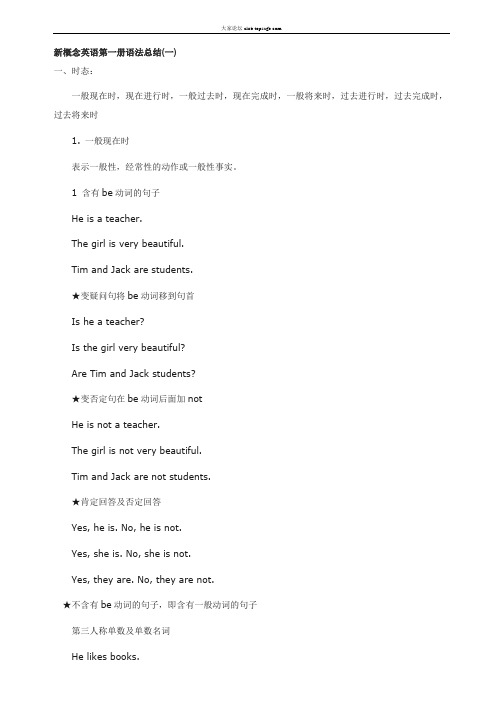
新概念英语第一册语法总结(一)一、时态:一般现在时,现在进行时,一般过去时,现在完成时,一般将来时,过去进行时,过去完成时,过去将来时1. 一般现在时表示一般性,经常性的动作或一般性事实。
1 含有be动词的句子He is a teacher.The girl is very beautiful.Tim and Jack are students.★变疑问句将be动词移到句首Is he a teacher?Is the girl very beautiful?Are Tim and Jack students?★变否定句在be动词后面加notHe is not a teacher.The girl is not very beautiful.Tim and Jack are not students.★肯定回答及否定回答Yes, he is. No, he is not.Yes, she is. No, she is not.Yes, they are. No, they are not.★不含有be动词的句子,即含有一般动词的句子第三人称单数及单数名词He likes books.She likes him.The dog likes bones.★变疑问句在句首加does, 动词变为原型Does he like books?Does she like him?Does the dog like bones?★变否定句在主语及动词之间加doesn’t, 动词变为原型,原句中的动词不再有第三人称变化。
He doesn’t like bo oks.She doesn’t like him.The dog doesn’t like bones.★肯定回答及否定回答:Yes, he does. No, he doesn’t.Yes, she does. No, she doesn’tYes, it does. No, it doesn’t.注意:第三人称单数形式一般在动词后面加S,不要和名词复数混淆,变否定句或疑问句时名词复数没有任何变化。
新概念英语第一册语法汇总
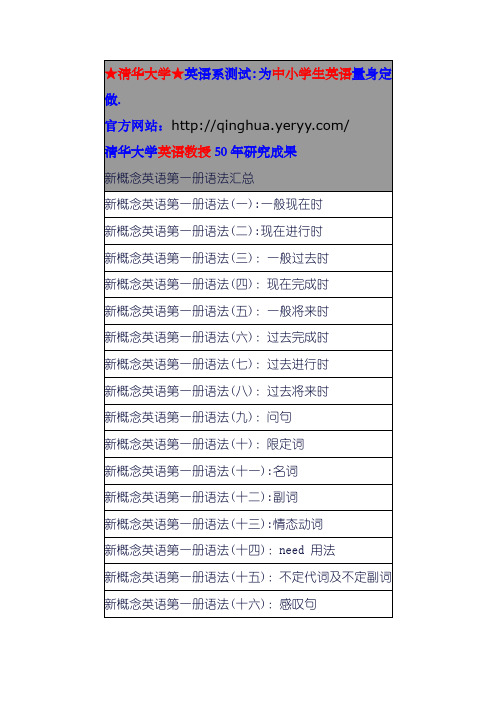
现在进行时表示现在正在进行的动作。
构成:主语+be动词+动词的现在分词+其它成分(现在分词的构成见附录)We are having lunch.He is reading a book.The dog is running after a cat.The boys are swimming across the river.★变疑问句将be动词移到句首Are we having lunch?Is he reading a book?Is the dog running after a cat?Are the boys swimming across the river?★变否定句在be动词后面加 notWe are not having lunch.He is not reading a book.The dog is not running after a cat.The boys are swimming across the river.★特殊疑问句:what, which, how, where, who, etc.疑问词+动词+主语+现在分词What are you doing?What is she doing?What is the dog doing?没有进行时的动词(必背)表示状态,思想,感情和感觉的动词不能表示正在进行的动作1. 表示感觉,感官的词see, hear, like, love, want,2. have, has当”拥有”讲时没有进行时一、时态:一般现在时,现在进行时,一般过去时,现在完成时,一般将来时,过去进行时,过去完成时,过去将来时1. 一般现在时表示一般性,经常性的动作或一般性事实。
1 含有be动词的句子He is a teacher.The girl is very beautiful.Tim and Jack are students.★变疑问句将be动词移到句首Is he a teacher?Is the girl very beautiful?Are Tim and Jack students?★变否定句在be动词后面加notHe is not a teacher.The girl is not very beautiful.Tim and Jack are not students.★肯定回答及否定回答Yes, he is. No, he is not.Yes, she is. No, she is not.Yes, they are. No, they are not.★不含有be动词的句子,即含有一般动词的句子第三人称单数及单数名词He likes books.She likes him.The dog likes bones.★变疑问句在句首加does, 动词变为原型Does he like books?Does she like him?Does the dog like bones?★变否定句在主语及动词之间加doesn’t, 动词变为原型,原句中的动词不再有第三人称变化。
新概念英语第一册所有语法点汇总)
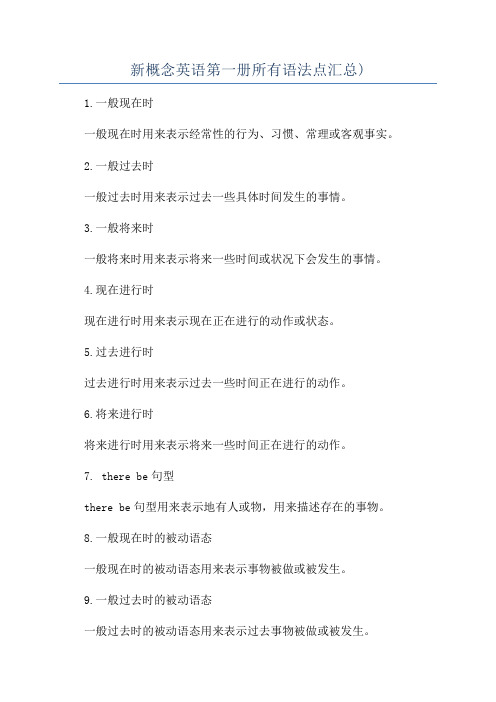
新概念英语第一册所有语法点汇总)1.一般现在时一般现在时用来表示经常性的行为、习惯、常理或客观事实。
2.一般过去时一般过去时用来表示过去一些具体时间发生的事情。
3.一般将来时一般将来时用来表示将来一些时间或状况下会发生的事情。
4.现在进行时现在进行时用来表示现在正在进行的动作或状态。
5.过去进行时过去进行时用来表示过去一些时间正在进行的动作。
6.将来进行时将来进行时用来表示将来一些时间正在进行的动作。
7. there be句型there be句型用来表示地有人或物,用来描述存在的事物。
8.一般现在时的被动语态一般现在时的被动语态用来表示事物被做或被发生。
9.一般过去时的被动语态一般过去时的被动语态用来表示过去事物被做或被发生。
10.一般将来时的被动语态一般将来时的被动语态用来表示将来事物将被做或被发生。
11.现在进行时的被动语态现在进行时的被动语态用来表示事物正在被做或被发生。
12.过去进行时的被动语态过去进行时的被动语态用来表示过去事物正在被做或被发生。
13. do与does的用法do和does用来构成否定句、疑问句和回答。
14.现在完成时现在完成时用来表示过去发生的动作对现在造成的影响或结果。
15.现在完成进行时现在完成进行时用来表示从过去开始一直延续到现在的动作,且这个动作可能还会继续下去。
16.过去完成时过去完成时用来表示过去在一些时间或事件之前已经完成的动作。
17.过去完成进行时过去完成进行时用来表示过去一些时间持续进行的动作,这个动作在另一个过去时间之前已经结束。
18.表示数量的词表示数量的词包括数词、基数词、序数词、分数和百分数等。
19.表示频率的词表示频率的词用来描述件事情发生的频率,如常常、经常、有时、很少、从不等。
20.表示时间的词表示时间的词用来描述一些事件发生的时间,如年、月、日、星期、时、分、秒等。
21.表示地点的词表示地点的词用来描述一些事件发生的地点,如国家、城市、街道、大楼等。
新概念英语一册语法总结

新概念英语一册语法总结.doc新概念英语第一册语法总结引言《新概念英语》第一册作为英语学习的入门教材,为学习者提供了基础的语法知识。
本文旨在总结第一册中的语法要点,帮助学习者更好地理解和掌握英语语法。
第一单元:基本句型陈述句肯定句:主语 + 动词 + 其他否定句:主语 + 助动词(do/does)+ not + 动词原形 + 其他一般疑问句结构:助动词(do/does)+ 主语 + 动词原形 + 其他?回答:Yes, 主语 + 助动词. / No, 主语 + 助动词 not.特殊疑问句结构:疑问词 + 助动词 + 主语 + 动词原形 + 其他?第二单元:时态一般现在时表示经常发生的动作或状态动词变化:S + V(原形)/ V(第三人称单数)现在进行时表示正在进行的动作结构:S + am/is/are + V-ing一般过去时表示过去发生的动作或状态结构:S + V-ed(规则动词)/ 特殊形式(不规则动词)现在完成时表示过去发生的动作对现在有影响或结果结构:S + have/has + V-ed第三单元:名词可数名词规则复数:名词 + -s或-es不规则复数:特殊形式不可数名词通常没有复数形式名词所有格表示所有关系:名词's 或 of 结构第四单元:代词人称代词主格:I, you, he, she, it, we, they宾格:me, you, him, her, it, us, them物主代词形容词性物主代词:my, your, his, her, its, our, their名词性物主代词:mine, yours, his, hers, its, ours, theirs 反身代词myself, yourself, himself, herself, itself, ourselves, themselves第五单元:形容词和副词形容词描述名词的性质或特征副词描述动词、形容词或其他副词比较级和最高级规则形式:比较级 -er, 最高级 -est不规则形式:特殊形式第六单元:介词时间介词in, on, at地点介词in, on, at, above, below, beside, behind, in front of方式介词by, with, through第七单元:连词并列连词and, but, or, yet, for, nor, so从属连词that, if, whether, who, what, where, when, how第八单元:冠词不定冠词a, an定冠词the零冠词在某些情况下可以省略冠词结论《新概念英语》第一册为英语学习者提供了扎实的语法基础。
(完整版)新概念英语第一册所有语法点汇总)

新概念英语第一册所有语法点汇总Lesson 1 人称代词含有be动词的陈述句、否定句和一般疑问句Lesson 3 祈使句简单的倒装句Lesson 5 冠词Lesson 6 选择疑问句Lesson 7 特殊疑问句一般疑问句Lesson 9 How…?的一些社交上的用法形容词的意义与作用Lesson 11所有格形容词和所有格代词名词所有格Lesson 15 名词可数名词单数变复数的规则Lesson 16 名词复数-s或-es的发音规则Lesson 19 There be句型常见方位介词:in、on、over、under Lesson 21 动词的双宾语Lesson 23 定语Lesson 27 some, any一些Lesson 29 情态动词情态动词must的用法Lesson 31 时态:共十六种时态,时态是通过动词变化来实现的。
现在进行时Lesson 34 动词+ing的规则Lesson 35 短语动词Lesson 37 be going to句型宾语补足语Lesson 39 祈使句do的用法Lesson 40 词组:动词+介词Lesson 43 情态动词can的用法Lesson 47 一般现在时Lesson 48 序数词Lesson 49 动词加s(es) 规则动词不定式some、any用法Lesson 51 What…(be,look…) like? 频率副词Lesson 57 一般现在时与现在进行时Lesson 59 have/has的用法Lesson 61 主语+系动词+表语Lesson 63 each和every的区别Lesson 64 禁令Don’t and Mustn’tLesson 65 日期的表达反身代词Lesson 67 一般过去时动词的过去式变化否定疑问句Lesson 69 用介词at,on和in的时间短语Lesson 74 副词的用法副词的构成Lesson 75 宾语从句Lesson 79 Must与NeedLesson 83 现在完成时Lesson 85 现在完成时的特殊结构Lesson 89 for与sinceLesson 91 一般将来时Lesson 95 had better和mustLesson 99 宾语从句Lesson 100 直接引语和间接引语Lesson 101 反意疑问句Lesson 103 too与enough的用法Lesson 105 动词不定式Lesson 107 形容词的比较级和最高级Lesson 111 形容词的平级比较级Lesson 113 so与neither引导的简短回答Lesson 116 不定代词Lesson 117 过去进行时概念和结构Lesson 119 过去完成时Lesson 121 定语从句Lesson 123 感叹句Lesson 125 must, have to和needn’tLesson 127 表示猜测和推断的情态助动词must和can’tLesson 131 情态助动词may表示可能性Lesson 133 需改变时态的间接陈述句Lesson 135 Let的用法Lesson 137 条件从句Lesson 141 被动语态新概念英语第一册语法点归纳大纲新概念英语第一册语法点归纳新概念一共144课,其中单课为课文,双课为语法和练习。
(完整版)最全的新概念英语第一册语法汇总[1],推荐文档
![(完整版)最全的新概念英语第一册语法汇总[1],推荐文档](https://img.taocdn.com/s3/m/392ebda0647d27284a73512b.png)
第一册重点语法知识点都包含:时态:一般现在时,现在进行时,现在完成时,一般过去时,过去进行时,过去完成时,一般将来时,过去将来时。
词性:动词现在分词、动词的过去式和过去分词。
形容词、副词的比较级与最高级。
助动词、情态动词、半情态动词的使用。
动词不定式。
反身代词、不定代词。
特殊疑问词。
句式:简单句、并列句、复合句(定语从句、状语从句、宾语从句)。
语态:被动语态。
结构:There be结构。
语序:倒装。
(新概念英语一册1-144课的所固定搭配短语)I beg your pardon 请您在重复(说)一遍Nice to meet you(too)(我也)很高兴见到你Look at…看… How do you do你好Be careful 小心A loaf of 一个 A bar of 一条 A bottle of 一瓶 A pound of 一磅Half a pound of 半磅 A quarter of 四分之一 A tin of 一听Hurry up 快点Next door 隔壁Black coffee 不加牛奶的咖啡White coffee 加牛奶的咖啡Come home from school 放学回家Come home from work 下班回家At the moment 此刻Wha t’s the time?几点钟?Come upstairs 上楼Come downstairs 下楼Hundreds of…数以百计的… On the way home 在回家的途中This morning 今天早晨This afternoon 今天下午This evening 今天晚上tonight 今天夜里Yesterday morning 昨天早晨Yesterday afternoon 昨天下午Yesterday evening 昨天晚上Last night 昨天夜里The day before yesterday in the morning 前天早晨The day before yesterday in the afternoon 前天下午The day before yesterday in the evening 前天晚上The night before last 前天夜间 A low mark 分数很底A high mark 分数很高She said to herself 她心中暗想The way to…到…的走法In fashion 流行的,时髦的I’m afraid…我恐怕…I’m sure…我确信,我肯定… A lot of 许多(用于肯定句)At all 丝毫、更本、一点也不Going on holiday 度假Have been to…到过… All the time 一直,始终Have been to…到过… Drive into…撞倒…For sale 供出售、出售Have the last word 最后决定、最后才算The R.A.F. 英国皇家空军Return ticket 往返票Next door to…与…相邻,在…隔壁In five hours’time在五小时之后。
最全的新概念英语第一册语法汇总

最全的新概念英语第一册语法汇总The first book covers key grammar points including: tenses such as simple present。
present continuous。
present perfect。
simple past。
past continuous。
past perfect。
simple future。
and future perfect。
parts of speech such as present participle。
past tense。
and past participle of verbs。
comparative and superlative forms of adjectives and adverbs。
the use of auxiliary verbs。
modal verbs。
semi-modal verbs。
infinitives。
reflexive pronouns。
indefinite pronouns。
and interrogative pronouns。
sentence structures such as simple。
compound。
and complex sentences (including adjective clauses。
adverb clauses。
and noun clauses)。
passive voice。
there be structures。
and word order。
including XXX。
the book includes fixed phrases XXX "I beg your pardon," "Nice to meet you (too)," "Look at," "How do you do," "Be careful," "A loaf of," "A bar of," "A bottle of," "A pound of," "Half a pound of," "A quarter of," "A tin of," "Hurry up," "Next door," "Black coffee," "White coffee," "Come home from school/work," "At the moment," "What's the time," "Come upstairs/downstairs," "Hundreds of," "On the way home," "XXX," "Tonight," "XXX,""Last night," "The day before XXX," and "The night before last." Lastly。
最全的新概念英语第一册语法汇总[1]文档
![最全的新概念英语第一册语法汇总[1]文档](https://img.taocdn.com/s3/m/f2daa9d8a32d7375a51780ec.png)
第一册要点语法知识点都包含:时态:一般此刻时,此刻进行时,此刻达成时,一般过去时,过去进行时,过去达成时,一般未来时,过去未来时。
词性:动词此刻分词、动词的过去式和过去分词。
形容词、副词的比较级与最高等。
助动词、神态动词、半神态动词的使用。
动词不定式。
反身代词、不定代词。
特别疑问词。
句式:简单句、并列句、复合句(定语从句、状语从句、宾语从句)。
语态:被动语态。
构造:Therebe 构造。
语序:倒装。
(新观点英语一册1-144课的所固定搭配短语)Ibegyourpar don请您在重复(说)一遍Nicetomeetyou(too)(我也)很快乐见到你Lookat看Howdoyoudo你好Becareful当心Alo afof一个Abarof一条Abottleof一瓶Apoundof一磅Halfapoundof半磅Aquarterof四分之一Atinof一听Hurryup快点Nextdoor近邻Blackcoffee不加牛奶的咖啡Whitecof fee加牛奶的咖啡Comehomefromschool下学回家Comehomefromwor k下班回家Atthemoment此刻What’sthetime?几点钟?Comeupstairs上楼Comedownstairs下楼Hundredsof数以百计的Onthewayhome在回家的途中Thismorn ing今日清晨Thisafternoon今日下午Thiseven ing今日夜晚tonight今日夜里Yesterdaymo rning昨天清晨Yesterdayafternoon昨天下午Yesterdayev ening昨天夜晚Lastnight昨天夜里Thedaybeforeyesterdayinthemor ning前天清晨Thedaybeforeyesterdayintheafter前天下午noonThedaybeforeyesterdayintheeve ning前天夜晚Thenightbeforel ast前天夜间Alowmark分数很底Ahighmark分数很高Shesaidtohe rself她心中暗想Thewayto到的走法Infashio n流行的,时兴的I’mafraid我唯恐I’msure我确信,我必定Alotof很多(用于必定句)Ata ll丝毫、更本、一点也不Goingonholiday度假Havebeen to到过Allthetime向来,一直Havebeen to到过Driveinto撞倒For sale供销售、销售Havethelastword最后决定、最后才算TheR.A.F .英国皇家空军Returnticket来回票Nextdoorto与相邻,在近邻Infivehours’time在五小时以后。
新概念英语第一册语法知识点
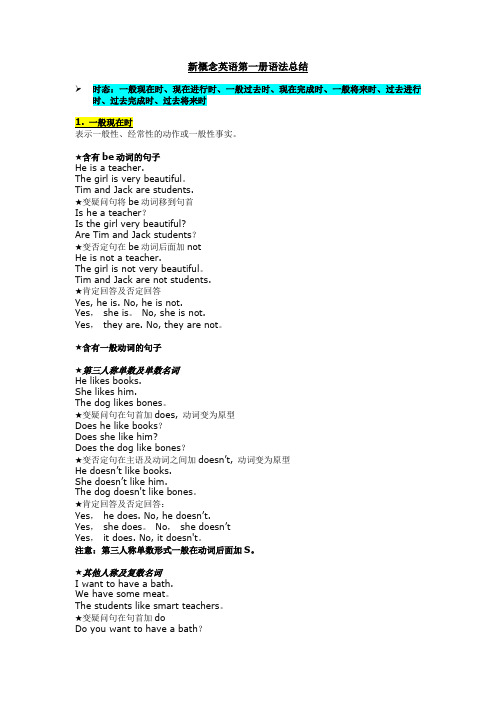
新概念英语第一册语法总结➢时态:一般现在时、现在进行时、一般过去时、现在完成时、一般将来时、过去进行时、过去完成时、过去将来时★含有be动词的句子He is a teacher.The girl is very beautiful。
Tim and Jack are students.★变疑问句将be动词移到句首Is he a teacher?Is the girl very beautiful?Are Tim and Jack students?★变否定句在be动词后面加notHe is not a teacher.The girl is not very beautiful。
Tim and Jack are not students.★肯定回答及否定回答Yes, he is. No, he is not.Yes,she is。
No, she is not.Yes,they are. No, they are not。
★含有一般动词的句子★第三人称单数及单数名词He likes books.She likes him.The dog likes bones。
★变疑问句在句首加does, 动词变为原型Does he like books?Does she like him?Does the dog like bones?★变否定句在主语及动词之间加doesn’t, 动词变为原型He doesn’t like books.She doesn’t like him.The dog doesn't like bones。
★肯定回答及否定回答:Yes,he does. No, he doesn’t.Yes,she does。
No,she doesn’tYes,it does. No, it doesn't。
注意:第三人称单数形式一般在动词后面加S。
★其他人称及复数名词I want to have a bath.We have some meat。
新概念英语第一册语法大全
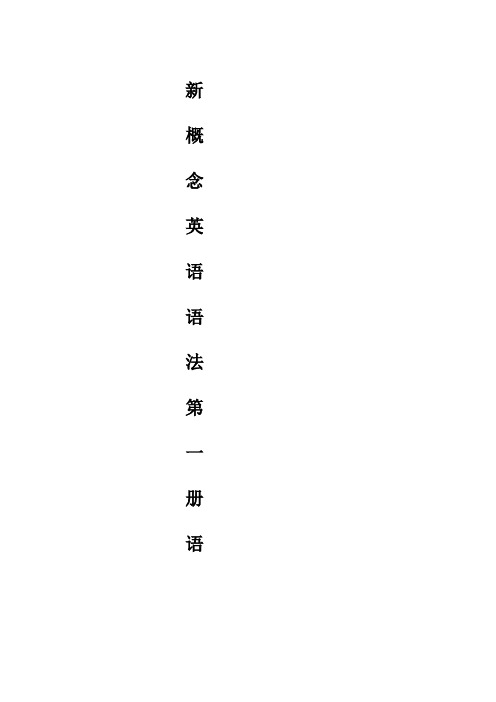
新概念英语语法第一册语一.时态:一般现在时,现在进行时,一般过去时,现在完成时,一般将来时,过去进行时,过去完成时,过去将来时1. 一般现在时表示一般性,经常性的动作或一般性事实。
◆......含有be 动词的句子He is a teacher.The girl is very beautiful.Tim and Jack are students.★变疑问句将be 动词移到句首Is he a teacher?Is the girl very beautiful?Are Tim and Jack students?★变否定句在be 动词后面加notHe is not a teacher.The girl is not very beautiful.Tim and Jack are not students.★肯定回答及否定回答Y es, he is. No, he is not.Y es, she is. No, she is not.Y es, they are. No, they are not.◆......不含有动词的句子,即含有一般动词的句子第三人称单数及单数名词He likes books.She likes him.The dog likes bones.★变疑问句在句首加does, 动词变为原型Does he like books?Does she like him?Does the dog like bones?★变否定句在主语及动词之间加doesn’t, 动词变为原型He doesn’t like books.She doesn’t like him.The dog doesn’t like bones.★肯定回答及否定回答:Y es, he does. No, he doesn’t.Y es, she doe s. No, she doesn’tY es, it does. No, it doesn’t.注意:第三人称单数形式一般在动词后面加S,不要和名词复数混淆,变否定句或疑问句时名词复数没有任何变化。
(完整版)最全新概念英语第一册语法汇总,文档

时态:大凡现在时,现在进行时,现在完成时,大凡过去时,过去进行时,过去完成时,大凡将来时,过去将来时。
性:在分、的去式和去分。
形容、副的比与最高。
助、情、半情的使用。
不定式。
反身代、不定代。
分外疑。
句式:句、并列句、复合句〔定从句、状从句、从句〕。
:被。
构: There be构。
序:倒装。
〔新看法英一册1-144的所不搭配短〕I beg your pardon 您在重复〔〕一遍Nice to meet you〔too〕〔我也〕很高到你Look at 看⋯⋯ How do you do你好 Be careful小心A loaf of 一个 A bar of 一条 A bottle of 一瓶 A pound of 一磅 Half a pound of 半磅 A quarter of 四分之一 A tin of 一听 Hurry up 快点 Next door 近邻 Black coffee 不加牛奶的咖啡White coffee 加牛奶的咖啡 Come home from school 放学回家Come home from work 下班回家 At the moment 现在 What’ s the time?几点? Come upstairs上楼 Come downstairs下楼Hundreds of 数⋯以百的⋯ On the way home在回家的途中This morning 今天清早 This afternoon 今天下午This evening今天夜晚 tonight 今天夜里Yesterday morning 昨天清早 Yesterday afternoon 昨天下午Yesterday evening昨天夜晚 Last night 昨天夜里The day before yesterday in the morning前天清早The day before yesterday in the afternoon 前天下午The day before yesterday in the evening前天夜晚The night before last 前天夜 A low mark 分数很底 A high mark 分数很高She said to herself她心中暗想 The way to 到⋯⋯的走法In fashion 流行的,髦的I ’ m afraid我恐⋯怕⋯I ’ m sure我⋯确信,我必然⋯ A lot of多〔用于必然句〕At all 毫、更本、一点也不Going on holiday 度假Have been to 到⋯⋯ All the time素来,始Have been to 到⋯⋯ Drive into 撞倒⋯⋯For sale 供销售、销售 Have the last word 最后决定、最后才算英.国皇家空Return ticket 往返票Next door to与⋯相,在⋯近邻In five hours’在time五小此后。
新概念第1册语法总结
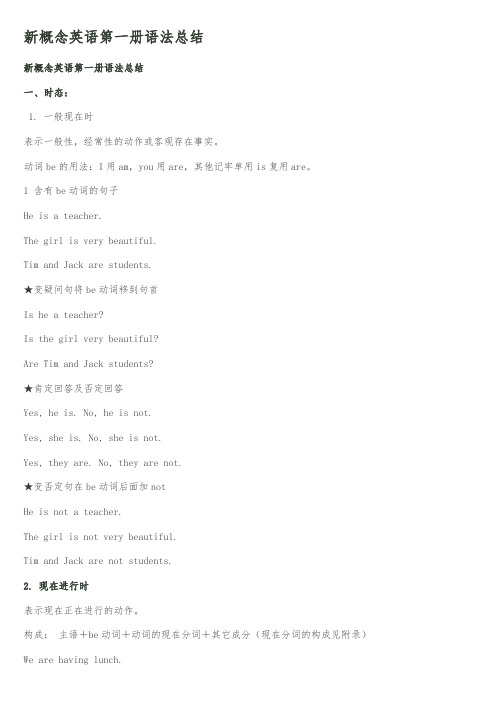
新概念英语第一册语法总结新概念英语第一册语法总结一、时态:1. 一般现在时表示一般性,经常性的动作或客观存在事实。
动词be的用法:I用am,you用are,其他记牢单用is复用are。
1 含有be动词的句子He is a teacher.The girl is very beautiful.Tim and Jack are students.★变疑问句将be动词移到句首Is he a teacher?Is the girl very beautiful?Are Tim and Jack students?★肯定回答及否定回答Yes, he is. No, he is not.Yes, she is. No, she is not.Yes, they are. No, they are not.★变否定句在be动词后面加notHe is not a teacher.The girl is not very beautiful.Tim and Jack are not students.2. 现在进行时表示现在正在进行的动作。
构成:主语+be动词+动词的现在分词+其它成分(现在分词的构成见附录)We are having lunch.He is reading a book.The dog is running after a cat.The boys are swimming across the river.★变疑问句将be动词移到句首Are we having lunch?Is he reading a book?Is the dog running after a cat?Are the boys swimming across the river?★变否定句在be动词后面加 notWe are not having lunch.He is not reading a book.The dog is not running after a cat.The boys are swimming across the river.★特殊疑问句:what, which, how, where, who, etc.疑问词+动词+主语+现在分词What are you doing?What is she doing?What is the dog doing?没有进行时的动词(必背)表示状态,思想,感情和感觉的动词不能表示正在进行的动作1. 表示感觉,感官的词see, hear, like, love, want,2. have, has当”拥有”讲时没有进行时3. 一般过去时:表示过去发生的动作或事件,常和表示过去的时间状语连用,如yesterday, last night, the day before yesterday, 3 days ago,含有be动词的句子,将动词变为过去式,am, is的过去式为was,are的过去式为wereI was at the butcher’s.You were a student a year ago.The teacher was very beautiful ten years ago.★变疑问句将be动词移动到句首Were you at the butcher’s?Were you a student a year ago?Was the teacher very beautiful ten years ago?★变否定句在be动词后面加notI wa s not at the butcher’s.You were not a student a year ago.The teacher was not very beautiful ten years ago.★肯定回答否定回答Yes, I was. No, I was not.Yes, you were. No, you were not.Yes, he/she was. No, he/she was not.★特殊疑问句:What did you do?(必背)不含有be动词的句子,将动词变为过去式,动词过去式构成见附录I finished my homework yesterday.The boy went to a restaurant.The Sawyers lived at King Street a year ago.★变疑问句在句首加did,动词变为原型Did you finish your homework yesterday?Did the boy go to a restaurant?Did the Sawyers live at King Street a year ago?★变否定句在主语和动词之间加did not,动词变回原形。
最新新概念英语第一册语法汇总
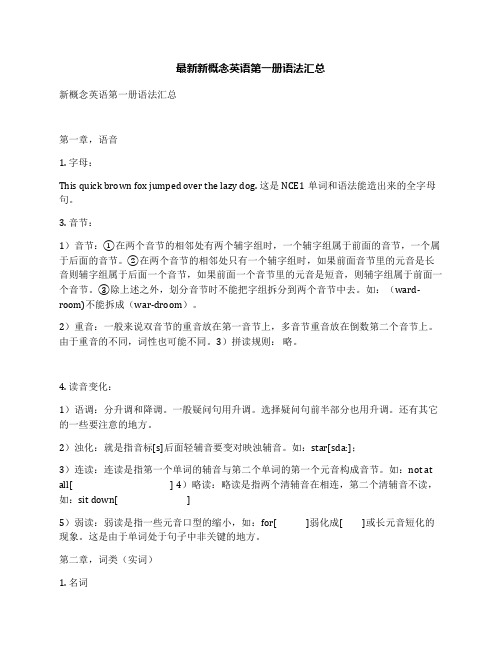
最新新概念英语第一册语法汇总新概念英语第一册语法汇总第一章,语音1. 字母:This quick brown fox jumped over the lazy dog. 这是NCE1单词和语法能造出来的全字母句。
3. 音节:1)音节:①在两个音节的相邻处有两个辅字组时,一个辅字组属于前面的音节,一个属于后面的音节。
②在两个音节的相邻处只有一个辅字组时,如果前面音节里的元音是长音则辅字组属于后面一个音节,如果前面一个音节里的元音是短音,则辅字组属于前面一个音节。
③除上述之外,划分音节时不能把字组拆分到两个音节中去。
如:(ward-room)不能拆成(war-droom)。
2)重音:一般来说双音节的重音放在第一音节上,多音节重音放在倒数第二个音节上。
由于重音的不同,词性也可能不同。
3)拼读规则:略。
4. 读音变化:1)语调:分升调和降调。
一般疑问句用升调。
选择疑问句前半部分也用升调。
还有其它的一些要注意的地方。
2)浊化:就是指音标[s]后面轻辅音要变对映浊辅音。
如:star[sda:];3)连读:连读是指第一个单词的辅音与第二个单词的第一个元音构成音节。
如:not at)略读:略读是指两个清辅音在相连,第二个清辅音不读,如:5)弱读:弱读是指一些元音口型的缩小,如:弱化成或长元音短化的现象。
这是由于单词处于句子中非关键的地方。
第二章,词类(实词)1. 名词名词主要学了两点:1.名词的复数,2.名词的格。
1.名词的复数:名词分可数和不可数两类。
只有可数名词有复数。
两者的区别在于:1.不可数名词不用a/an修饰。
2.不可数名词做主语用单三。
3.不可数名词除非特指,也不用the。
4.有些形容词只修饰不可数名词(little、much),有些只修饰可数(few、many),或者两者都行(some、a lot of)。
5.不可数名词由一个介词短语修饰则试为一个可数名词,如:Tow loaves of bread.可数名词的复数:1.直接加s,清辅音读[s],否则读[z]。
- 1、下载文档前请自行甄别文档内容的完整性,平台不提供额外的编辑、内容补充、找答案等附加服务。
- 2、"仅部分预览"的文档,不可在线预览部分如存在完整性等问题,可反馈申请退款(可完整预览的文档不适用该条件!)。
- 3、如文档侵犯您的权益,请联系客服反馈,我们会尽快为您处理(人工客服工作时间:9:00-18:30)。
Half a pound of 半磅 A quarter of 四分之一 A tin of 一听Hurry up 快点Next door 隔壁 Black coffee 不加牛奶的咖啡White coffee 加牛奶的咖啡 Come home from school 放学回家Come home from work 下班回家 At the moment 此刻What’s the time? 几点钟?Come upstairs 上楼 Come downstairs 下楼Hundreds of…数以百计的… On the way home 在回家的途中This morning 今天早晨 This afternoon 今天下午This evening 今天晚上 tonight 今天夜里Yesterday morning 昨天早晨 Yesterday afternoon 昨天下午Yesterday evening 昨天晚上 Last night 昨天夜里The day before yesterday in the morning 前天早晨The day before yesterday in the afternoon 前天下午The day before yesterday in the evening 前天晚上The night before last 前天夜间 A low mark 分数很底 A high mark 分数很高She said to herself 她心中暗想The way to…到…的走法In fashion 流行的,时髦的I’m afraid…我恐怕…I’m sure…我确信,我肯定… A lot of 许多(用于肯定句)At all 丝毫、更本、一点也不 Going on holiday 度假Have been to…到过… All the time 一直,始终Have been to…到过… Drive into…撞倒…For sale 供出售、出售 Have the last word 最后决定、最后才算The 英国皇家空军 Return ticket 往返票Next door to…与…相邻,在…隔壁In five hours’time在五小时之后。
Go back 返回 The othe day 几天前Fell downstairs 从楼上摔下来 The 青年招待所协会Cheer up 振作起来Full of…充满了…Would you like…?你愿意…?Could you…?你能…?(比Can you…?更婉转客气)Buy…on instalments以分期付款的方式购买… Small change 零钱Go back to sleep 继续睡觉To take…with…把…带上(with 后跟人称宾格)Have to 不得不(过去式Had to) By myself 我自己By yourself 你自己 By himself 他自己By herself 她自己 By itself 它自己By ourselves 我们自己 By yourselves 你们自己By themselves 他/她/它们自己 By oneself 独自的Not that long ago 没那么久He can’t be…他不可能… He must be 他肯定是…He can’t have been…他那时不可能… He must have benn…他那时肯定是…Don’t be so sure别那么肯定He may…他可能…He might…他可能…(没有He might…的程度强)Make up…minds打定主意(up后跟人称宾格) Look after 照看 In the end 最后 In the first instance 首先,起初He may be…他可能是 He may have been他可能己经… I’m ot sure我不敢肯定I wonder why 我想知道为什么 A long time (ago) 很早(前)Get married 结婚Depend on…依靠,取决于…I’m late for…我因为…而迟到 By the way 顺便(问,说)I’m dressed in…我穿戴着… Make up her face 往她的脸上施脂粉Make myselft beautiful 把自己打扮漂亮 Was coveredwith…覆盖着…I went for…(…表明目的) Pice of paper 纸片 Cigarette ends 烟头Take out 拿出 Put away 放到一边 Hundredso f…成百上千的…Round the world 周游世界季节、月份、星期Spring 春节 Summer 夏天 Autumn 秋天Winter 冬天January 一月 February 二月 March 三月April 四月 May 五月June 六月 July 七月 August 八月September 九月October 十月November 十一月 December 十二月 Monday 星期一Tuesday 星期二Wednesday 星期三 Tursday 星期四 Friday 星期五Saturday 星期六Sunday 星期日 Weekend 周未(请记住以下特殊疑问句的特殊疑问词)1、 Why (有关原因)2、 What (有关事物)3、 Which (有关事物)4、 Who (有关人物)5、 Whose (有关人物)6、 Where (有关地点)7、 When (有关时间)8、 How (有关方法或状态)第一部份:词法(请记注以下词性概念,具体的用法参考我们所学过的课文)一、动词:(表示动作或状态等。
)1、记住以下常见系动词Appear Be Become Fall Feel GetGo Grow Keep Look Prove RemainRest Run Seem Smell Sound StayTaste Rurn2、记住以下常见助动词Be Have Do Will Sould Shall Should3、记住以下常见情态动词Can Could May Might Must Ought4、记住以下常见半情态动词Need Dare Be ableto Have(got)to Had better(best) Used to二、冠词(用在名词前帮助说明其词义)三、名词(表示人或事物的名称)四、代词(用来代替名词或数词等,包含反身代词)五、形容词(用来修饰名词或代词)六、副词(用来修饰动词、形容词、或副词)七、介词(用在名词、代词等前面,表示与别的词的关系)八、数词(表示数目或顺序)九、连词(用来加接词与词或句与句)十、感叹词(表示说话时的感情或口气)第二部分:词法规则一、可数名词的复数规则变化1、一般情况下未尾加“s”。
2、以x,ss,sh,ch,x结尾的名词加“es”。
3、以ce,se,ze,(d)ge结尾的词加“s”。
4、以辅音字母+y结尾的词,变“y”为“i”在加“es”。
5、以元音字母+y结尾的词,直接加“s”。
6、以f,fe结尾的名词一般变“f”或“fe”为“v”在加“es”。
(以f或fe结尾的部分名词可直接加“s”)7、以o结尾的名词一般加“s”。
(部分以辅音字母+o结尾的加“es”)二、规则动词的过去式与过去分词变化与动词现在分词的变化1、一般动词过去式在未尾加“ed”。
2、结尾是e的动词加“d”。
3、未尾只有一个辅音字母的重读闭音节词,先双写这个辅音字母,再加“ed”。
4、结尾是辅音字母+y的动词,先变“y”为“i”在加“ed”。
5、动词的现在分词一般情况下在原形后加“ing”。
6、如果以e结尾的动词则去“e”在加“ing”来构成现在分词。
7、如果动词只有一个元音字母,而后面跟了一个辅音字母时,则需双写辅音字母再加“ing”来构成动词的现在分词。
三、形容词与副词的比较级、最高级(比较级在未尾加“er”而最高级在未尾加“est”)它们都遵循着以下规则1、一般情况下单音节的形容词或副词则在原形未尾加“er”。
2、如果以e结尾的形容词或副词则加“r”。
3、有些以y结尾的双音节词,如果y前面是一个辅音字母则变“y”为“i”在加“er”。
(如果是最高级则在形容词前加冠词“The”然后形容词或副词未尾加“est”,其它规则一样。
)第三部分:句法规则(时态)1、一般现在时:(除主语第三人称)谓语动词都使用动词原形。
常与副词“always”,“never”,“often”,“seldom”,“usually”,“every”,“day”等连用。
2、现在进行时:表示现在正在进行的动作。
语法:Be+动词现在分词3、现在完成时:表动作发生在过去,但与现在有关系。
即用一个发生在过去的动作来说明现在的情况。
语法:Have+动词过去分词4、一般过去时:表过去某个时间发生的动作或存在的状态,也表示过去常发生的动作。
语法1(be动词):主语+be动词过去式语法2:主语+动词过去式5、过去进行时:表某一时刻或某一段时间内正在进行或持续进行的作动。
语法:Be动词过去式+动词现在分词6、过去完成时:表在过去某一时间或动作以前己经完成的动作。
语法:Had+动词过去分词构成7、一般将来时:表将来某个时间要发生的动作或存在的状态,也表将来经常或反复发生的动作。
语法1:Will(Shall)+动词原形语法2:Be+going go+动词原形8、过去将来时:表从过去某一时间看将要发生的动作或存在的状态。
语法1:Would(Should)+动词原形语法2:Be动词过去式+going to+动词原形第四部分:句法规则(从句)一、宾语从句:宾语从句是由一个完整的句子构成,充当宾语修饰谓语动词、介词和、限定动词和某些形容词的宾语。
如果从句部份是一个陈述句或是一个一般疑句(一般疑问句如果做为从句则需变为陈述句)则通常使用引导词“that”、“whether”、“if”加上从句部份来构成宾语从句。
如果从句部份是一个特殊疑问句,而把特殊疑问词做引导词在加上由一般疑问句变来的陈述句来构成宾语从句。
例1:由that、whether或if引导的宾语从句。
1、She saw that her was sleeping. 她看见他在睡觉(修饰谓语动词“saw”)。
2、She was intersted in whatever she saw there. 他对在那无论所看到的都感兴趣(修饰介词“in”)。
3、She didn’t say if her was still alive. 他没有说他是否还活着(修饰谓语动词“say”)。
